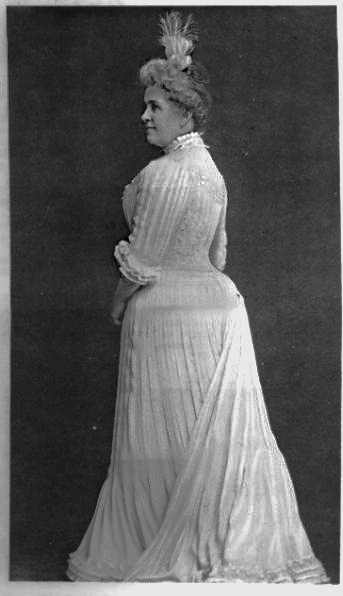AGNES
POTTER (SCOFIELD)

As a young woman in the Village of Oconto,
little did Agnes Potter
know that life would include being a "First Lady" of Wisconsin as the
spouse
of a two term governor. In 1870, Agnes married a Veteran Civil War
Major
originally from Pennsylvania who, after the war, had become a civil
engineer
in Chicago, and had worked his way to lumber plant manager in Oconto.
Over
the years she and Edward Scofield had two sons and a daughter. Agnes
lived
the busy life of a business man's wife, which included not only raising
their children, but attending to many business and domestic details
during
her husband's numerous lengthy absences. She became competent in all
manner
of dealing with people from every walk of life on any number of issues.
As a woman of Victorian times, it was also important that she "keep to
her place" as a lady and not be seen as trying to "outdo" her husband
while
attending to these matters. She managed the delicate balance.
It was good training for her future experiences
as a political wife
of the time. The Schofield's focus was investing in mills and lumber
companies
until 1886 when her husband was elected to State Senate. Edward
Scofield
was an outgoing and popular man, which put considerable pressure on
Agnes
to compliment his political career by maintaining a constant welcoming,
pleasant, and open atmosphere within their household to any and all
comers.
Social dictates of Victorian times were rigid and strenuous; demanding
a person intelligent and experienced in protocol for a never-ending
series
of events, galas, sorees, tea parties, return visitations,
entertaining,
formal dinners and the like. There were also the daily responsibilities
of keeping the budget and running a household of servants. All must be
done with the continuous "grace and form" of a sophisticated woman. Her
days often started with answering stacks of necessary written social
correspondances
at 5:30 am and frequently continued well past midnight, a minimum of 6
days a week. Clothing of the day was as rigid as the social structure
and,
for women "of means", could easily weight 50 to 80 pounds in winter.
This
was a time that gave birth to the manditory 16 inch waistline, smelling
salts and fainting couches. Agnes survived and flurished.
Agnes and Edward Scofield lived in the
Governors Mansion from January
4, 1897 to January 7, 1901. Years later, in 1948, they were guests of
honor
at the celebration of Wisconsin's Centennial as a State in Oconto.
|
![]()
![]()
![]()
![]()
![]()
![]()